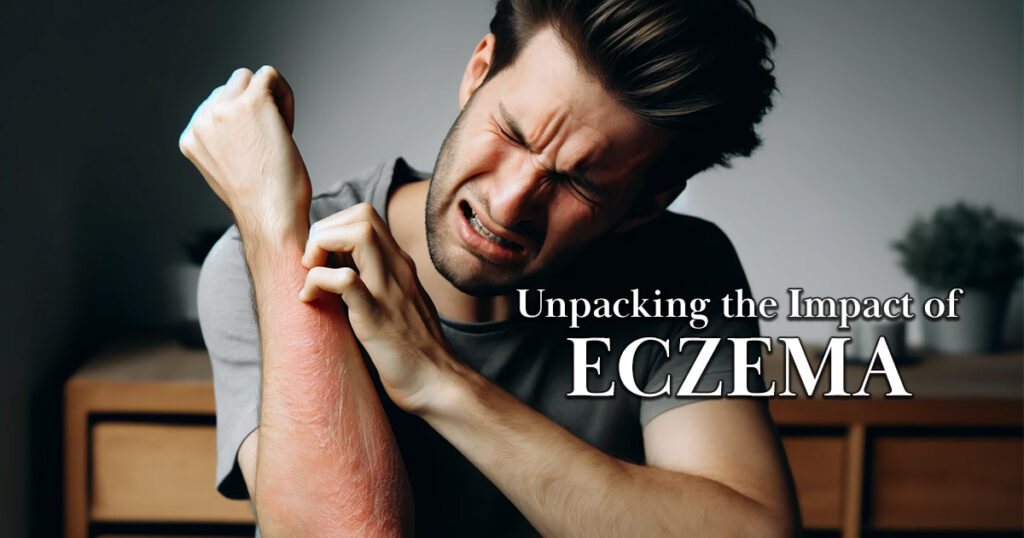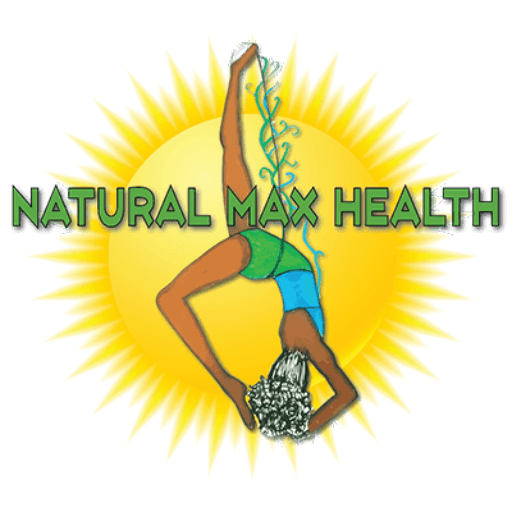Exploring the Rise of Eczema in the U.S. From Diet to Environment

Chronic Itch: Unpacking the Impact of Eczema in America Today
In the United States, an alarming paradox exists: despite an abundance of food, our diets, lifestyle choices, and environmental factors leave us not just overfed but also deeply undernourished. This nutritional crisis manifests in various health issues, one of which is eczema—a condition affecting over 31.6 million Americans. Defined by the National Eczema Association as a chronic, inflammatory skin disease, eczema torments its sufferers with relentless itching and dry skin that, when scratched, can weep clear fluid. Recent findings published by WebMD on March 6th, 2024, highlight the pervasive impact of this disease, underscoring the urgent need for a deeper understanding of our health and environment.
In addition to dry, itchy skin, eczema causes problems with the skin barrier, which increases bacteria on the skin. This results in eczema-prone skin being more prone to skin infections from both bacteria and viruses, especially staph and herpes. Symptoms of skin infections include redness, pus-filled bumps or pimples, cold sores or blisters, and skin that is either warm or hot to the touch. If there is even the slightest possibility that you may have a skin infection, please see your healthcare provider immediately.
Skin infections are not the only symptoms that those suffering from eczema-prone skin have to be concerned about. The very nature of eczema itself causes a condition called “comorbidities.” Comorbidities are conditions in which two chronic diseases or illnesses exist in your body at the same time. People with eczema have several known comorbidities or health-related conditions, such as asthma, hay fever, allergies, and food allergies.
What Are The Different Types of Eczema
There are several types of eczema: atopic dermatitis, contact dermatitis, dyshidrotic eczema, neurodermatitis, nummular eczema, and seborrheic dermatitis. Let’s discuss the unique triggers of each type.
Atopic dermatitis – According to the National Eczema Association, this is the most common type of eczema, affecting more than 9.6 million children and about 16.5 million adults in the United States alone. This chronic condition can come and go for years or throughout life and can, unfortunately, overlap with other types of eczema. People with atopic dermatitis have several known comorbidities. Atopic dermatitis is part of a group of allergic conditions known as the “atopic march,” which consists of other conditions such as asthma, hay fever, and food allergies. If a person has one atopic condition, they are more likely to develop another.
Atopic dermatitis is often called “the itch that rashes,” according to the American Academy of Dermatology Association. Symptoms start suddenly with very itchy skin that demands attention. Frequent scratching or rubbing of the skin can result in a rash. In addition to dry, itchy, scaly skin in the area, one might also experience:
- Small rough bumps
- Dark brown, purple, or grayish areas of skin
- Scratch marks
- Bleeding
- Raw skin from scratching
- Bumps or rashes leaking fluid
- Blisters that ooze and crust over
- Lighter or darker skin after the area has healed
Flare-ups can come and go for years. While the skin is healing in one area, flare-ups may occur in other areas. It has been my experience that flare-ups can also occur in the same place time after time. Over time, atopic dermatitis can cause the skin to become cracked, thickened, scaly, and leathery. In my experience, the skin can also burn and sting, causing one to feel extremely frustrated and sometimes powerless.
Contact dermatitis – As the name suggests, contact dermatitis occurs when the skin comes into contact with irritants or allergens, leading to redness, itching, and blistering. Swelling, burning, or tenderness are prevalent symptoms of contact dermatitis. Irritant contact dermatitis stems from exposure to harsh symptoms such as detergents and even pollen with a high count—allergic contact dermatitis results from reactions to specific agents such as nickel or latex.
The key to managing or keeping contact dermatitis at bay is identifying and avoiding the irritant or allergen. Consequently, dermatologists and other medical professionals often recommend avoiding scented or fragranced soaps, lotions, creams, and laundry detergents. Adhering to this advice can help one avoid any possible allergies or skin irritations due to the chemicals in these products.
Dyshidrotic eczema – This condition is more prevalent in women and is accompanied by tiny fluid-filled blisters on the palms, fingers, and soles of the feet. Symptoms usually last about three to four weeks and include a severe itch that cannot be ignored. The etiology of this type of eczema is unknown. Still, it is believed to be associated with atopic dermatitis and exposure to allergens or irritants.
Neurodermatitis (lichen simplex chronicus) – Is characterized by chronic itching or scaling. The more you scratch or rub neurodermatitis, the itchier it often becomes. Most people will develop one or two itchy patches, and scratching the skin patch typically causes the rash. People suffering from this form of eczema will have raised and rough, itchy areas of skin that are usually on the scalp, neck, wrist, forearms, legs, or groin area. Unfortunately, when the itch begins in the groin area, it tends to develop on the anus, scrotum, or vulva.
Many report that these itchy patches tend to come and go and are most bothersome when relaxing or trying to sleep. Unfortunately, since this can affect sleep, the condition can adversely affect the quality of life. People suffering from this neurodermatitis say the itch begins when they feel stressed, anxious, or worried. Ironically enough, the intense itch can also cause one to feel stressed out, anxious, or worried.
Like other forms of eczema, frequent scratching can lead to skin infections or bleeding sores. Over time, repeated scratching will cause the skin to thicken—the body’s way of protecting you as the thickened skill will bleed less and develop fewer infections.
As you can see, all forms of eczema cause the skin to itch intensely. This common denominator can make it challenging to pinpoint what form of eczema, if any, you may have. If you think you may have neurodermatitis, some of the signs include:
- Repeatedly scratching or rubbing a few itchy patches of skin
- Having an itch that interferes with your daily routine, such as waking up or preventing you from doing certain activities like dating or traveling
- Developing rashes or sores that bleed
Nummular dermatitis – This condition causes inflamed coin-shaped rashes or sores that are prone to oozing and crusting to appear on the skin, more commonly the torso or limbs. People with nummular eczema often have very dry or xerotic skin. Although the cause is unknown, this condition is believed to result from some form of trauma, such as bites from arthropods or other injuries. Contact with chemicals or abrasions may also cause an outbreak.
Seborrheic dermatitis – This is a common skin condition that primarily affects the scalp. It causes scaly patches, inflammation, and persistent dandruff. The condition also commonly affects areas of the body rich in oil glands, such as the face, sides of the nose, eyebrows, ears, eyelids, and chest.
Seborrheic dermatitis, also known as dandruff, seborrheic eczema, and seborrheic psoriasis, is also present in infants and is called “cradle cap.”
Symptoms include:
- Flaking skin or dandruff on your scalp, hair, eyebrows, beard or mustache
- Patches of greasy skin covered with flaky white or yellow scales or crust on the face, sides of the nose, eyebrows, ears, eyelids, chest, armpits, groin area, or under the breasts
- Rashes that may look darker or lighter on people with brown or black skin and redder on those with white skin
An overgrowth of yeast, alongside genetic and environmental factors, is believed to contribute to its onset.
Who Gets Eczema?
The onset of eczema is not always known, but your environment plays a significant role in how likely you are to get eczema. According to the eczema guide published by Web MD, if you live in an urban setting or you’re around specific allergens like mold and dust, you have a higher chance of developing this condition.
Multiple studies have confirmed that higher-income regions are associated with increased eczema rates. In addition, the studies found that those in metropolitan areas with more formal education tend to have higher rates of eczema. The exact reasons for the prevalence of eczema in urban areas are unknown, but the hypotheses are linked to environmental factors like air pollution from motor vehicles and modern fuels like kerosene used in homes. Although, some experts believe that eczema is more common in developing countries because of childhood vaccines and antibiotics used to lower diseases and infection rates. However, vaccines and antibiotics can also alter your immune response, increasing the likelihood of developing an atopic disease like eczema, according to some studies.
In Conclusion
Eczema’s impact extends far beyond the skin, disrupting sleep and precipitating a cascade of health issues. The relentless itching and persistent skin irritations can fray the nerves, severely affecting mental health and well-being. Furthermore, visible rashes and thick, scaly skin can erode self-esteem, pushing sufferers toward social isolation.
Eczema can be triggered by a variety of factors, including environmental elements and even parasites. In my next article, we’ll delve deeper into the diverse causes of this challenging condition. For now, consider the role of your surroundings, especially if you or someone you care about struggles with eczema. Mold, often overlooked, can be a significant irritant, leading to dry, itchy skin and exacerbating conditions like atopic dermatitis. This is particularly relevant for those living or working in mold-prone areas, including many college students who face mold issues in dormitories. Understanding and managing your environment is crucial in combating eczema and other related allergens.
I hope that you have found this article insightful. If it blessed you, please share it with someone who may also be blessed by it. Until next time, take care of yourselves, happy healing, see you soon, and God bless.
Related Links
Recovery From Mold Toxicity: How to Start the Healing
Mold Toxicity: It May Be Why You’re Sick
